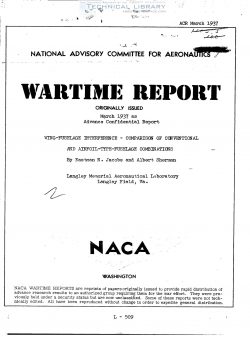naca-wr-l-509
- Version
- 202 Downloads
- 586.31 KB File Size
- 1 File Count
- April 2, 2017 Create Date
- April 2, 2017 Last Updated
Wing Fuselage Interference - Comparison of Conventional and Airfoil Type Fuselage Combinations

SUMIARY
Tests of wing-fuselage combinations employing an air—
foil—type fuselage were made in the variable—density wind
tunnel as a-pnrt of the wing-fuselage interference program
being conducted therein. The models were designed to simu—
late an existing moderate-size transport airplane of that
type. The test results showed that for such sizes, at
least, the airfoil-type-fuselage combination should be well
faired in such a way as to eliminate thetfiscnntinuity at
the ends of the fuselage. and even then will probably have
to rely largely on other than basic aerodynamic considera—
tions for its Justification.
INTRODUCTION
A comprehensive investigation of wing-fuselage inter—
ference is in progress in the N.A.C.A. variable-density
tunnel. Results of partsof the investigation have been
reported in references 1 and 2. The general program is
outlined in reference 1. As a part of the program. a wing—
fuselage combination consisting of one of the standard
wings combined with an airfoil-type fuselage was briefly
investigated.
The airfoil—type—fuselage combination is character-
ized by an enlarged and thickened central portion of the
wing. This central portion.is made sufficiently large and
thick to accommodate the passengers and cargo and other-
wise te take the place of the usual fuselage. The tail
surfaces are carried on booms.
The airfoil—type-fuselage combination obviously be-
comes aerodynamically desirable when, for large airplanes,
the space and height requirements of the fuselage portion
are such that it becomes substantially an integral part of
an efficient wing. The whole combination then becomes
simply a flying wing. the characteristics of which should
be readily predicted from airfoil-section data and wing
theory. The type of combination that has been used in
moderate—sine transport airplanes, however, requires spe-
cial investigation. It is characterised by a markedly
thickened and enlarged central portion of the wing having
substantially flat sides. The principal object of the
present investigation was to compare this type of combina—
tion with one of the best wing-fuselage combinations of
the conventional type.
DESIGN OF MODEL
The principal design requirements were: First, that
the proportions should be somewhat like those of an actual
airplane of the airfoil-fuselage type: and second. that
the.wing-fuselage combination should be directly compara-
ble with some of the conventional combinations previously
investigated. The combination was therefore designed
around the N.A.G.L. 0018-09 tapered airfoil (reference 1).
The ratio of fuselage chord to fuselage span and the ratio
of fuselage thickness to fuselage chord (23 percent) were
taken from the Burnelli UB 14A airplane (reference 3).
The fuselage chord was then adjusted to give the airfoil—
type fuselage the same useful volume as the conventional
fuselage previously employed. considering only the forward
60 percent of the conventional fuselage to represent use-
ful volume. This procedure gave:
| File | Action |
|---|---|
| naca-wr-l-509 Wing Fuselage Interference - Comparison of Conventional and Airfoil Type Fuselage Combinations.pdf | Download |

Comment On This Post